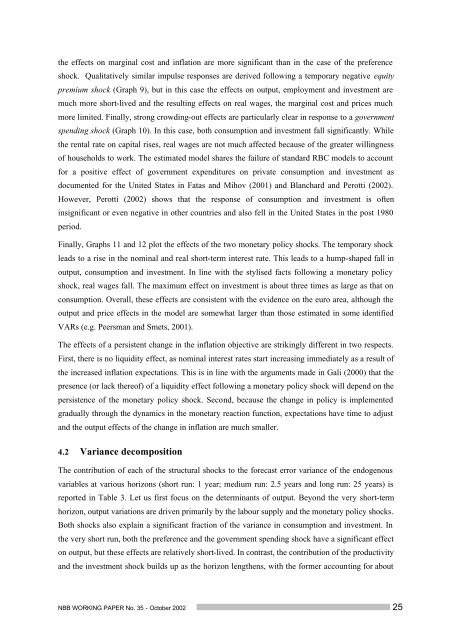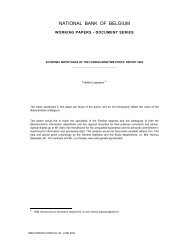An estimated dynamic stochastic general equilibrium model of the ...
An estimated dynamic stochastic general equilibrium model of the ...
An estimated dynamic stochastic general equilibrium model of the ...
You also want an ePaper? Increase the reach of your titles
YUMPU automatically turns print PDFs into web optimized ePapers that Google loves.
<strong>the</strong> effects on marginal cost and inflation are more significant than in <strong>the</strong> case <strong>of</strong> <strong>the</strong> preferenceshock. Qualitatively similar impulse responses are derived following a temporary negative equitypremium shock (Graph 9), but in this case <strong>the</strong> effects on output, employment and investment aremuch more short-lived and <strong>the</strong> resulting effects on real wages, <strong>the</strong> marginal cost and prices muchmore limited. Finally, strong crowding-out effects are particularly clear in response to a governmentspending shock (Graph 10). In this case, both consumption and investment fall significantly. While<strong>the</strong> rental rate on capital rises, real wages are not much affected because <strong>of</strong> <strong>the</strong> greater willingness<strong>of</strong> households to work. The <strong>estimated</strong> <strong>model</strong> shares <strong>the</strong> failure <strong>of</strong> standard RBC <strong>model</strong>s to accountfor a positive effect <strong>of</strong> government expenditures on private consumption and investment asdocumented for <strong>the</strong> United States in Fatas and Mihov (2001) and Blanchard and Perotti (2002).However, Perotti (2002) shows that <strong>the</strong> response <strong>of</strong> consumption and investment is <strong>of</strong>teninsignificant or even negative in o<strong>the</strong>r countries and also fell in <strong>the</strong> United States in <strong>the</strong> post 1980period.Finally, Graphs 11 and 12 plot <strong>the</strong> effects <strong>of</strong> <strong>the</strong> two monetary policy shocks. The temporary shockleads to a rise in <strong>the</strong> nominal and real short-term interest rate. This leads to a hump-shaped fall inoutput, consumption and investment. In line with <strong>the</strong> stylised facts following a monetary policyshock, real wages fall. The maximum effect on investment is about three times as large as that onconsumption. Overall, <strong>the</strong>se effects are consistent with <strong>the</strong> evidence on <strong>the</strong> euro area, although <strong>the</strong>output and price effects in <strong>the</strong> <strong>model</strong> are somewhat larger than those <strong>estimated</strong> in some identifiedVARs (e.g. Peersman and Smets, 2001).The effects <strong>of</strong> a persistent change in <strong>the</strong> inflation objective are strikingly different in two respects.First, <strong>the</strong>re is no liquidity effect, as nominal interest rates start increasing immediately as a result <strong>of</strong><strong>the</strong> increased inflation expectations. This is in line with <strong>the</strong> arguments made in Gali (2000) that <strong>the</strong>presence (or lack <strong>the</strong>re<strong>of</strong>) <strong>of</strong> a liquidity effect following a monetary policy shock will depend on <strong>the</strong>persistence <strong>of</strong> <strong>the</strong> monetary policy shock. Second, because <strong>the</strong> change in policy is implementedgradually through <strong>the</strong> <strong>dynamic</strong>s in <strong>the</strong> monetary reaction function, expectations have time to adjustand <strong>the</strong> output effects <strong>of</strong> <strong>the</strong> change in inflation are much smaller.4.2 Variance decompositionThe contribution <strong>of</strong> each <strong>of</strong> <strong>the</strong> structural shocks to <strong>the</strong> forecast error variance <strong>of</strong> <strong>the</strong> endogenousvariables at various horizons (short run: 1 year; medium run: 2.5 years and long run: 25 years) isreported in Table 3. Let us first focus on <strong>the</strong> determinants <strong>of</strong> output. Beyond <strong>the</strong> very short-termhorizon, output variations are driven primarily by <strong>the</strong> labour supply and <strong>the</strong> monetary policy shocks.Both shocks also explain a significant fraction <strong>of</strong> <strong>the</strong> variance in consumption and investment. In<strong>the</strong> very short run, both <strong>the</strong> preference and <strong>the</strong> government spending shock have a significant effecton output, but <strong>the</strong>se effects are relatively short-lived. In contrast, <strong>the</strong> contribution <strong>of</strong> <strong>the</strong> productivityand <strong>the</strong> investment shock builds up as <strong>the</strong> horizon leng<strong>the</strong>ns, with <strong>the</strong> former accounting for aboutNBB WORKING PAPER No. 35 - October 2002 25
















